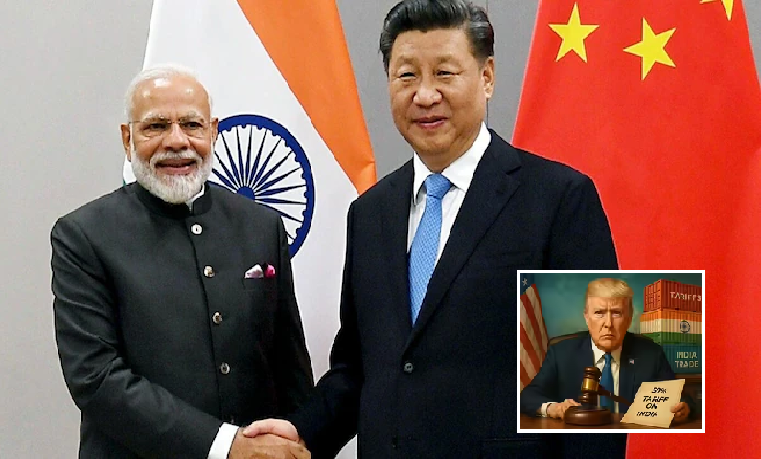
- Trump’s tariff war, intended to isolate China and pressure India, instead pushed the two Asian rivals into a tactical alignment, bound by shared economic vulnerabilities and the need for growth, investment, and affordable energy.
- India and China, both crucial engines of global growth, faced parallel challenges from U.S. protectionism; while India resisted American pressure despite investor flight and a weakening rupee, China leveraged its ability to retaliate, exposing Washington’s policy inconsistencies.
- India’s negotiations with Washington revealed pragmatism but limits—offering tariff cuts on industrial goods but refusing concessions on sensitive agriculture and dairy sectors, unlike South Korea, which yielded to U.S. demands.
- The current India–China cooperation is pragmatic and tactical, not a strategic reset; despite limited agreements on trade, flights, and exports, mistrust endures due to border tensions and China’s ties with Pakistan, making this a marriage of convenience shaped by U.S. tariffs rather than genuine reconciliation.
The ongoing tariff disputes initiated under U.S. President Donald Trump have reconfigured the global economic landscape in unexpected ways. What was maybe originally intended as an idea to isolate China and exert pressure on India has instead fostered an odd tactical alignment between Asia’s two economic powerhouses. The “dragon and the elephant,” long seen as regional competitors with overlapping domains of influence, are now moving in conscious rhythm, bound together by the shared obstacle of navigating Washington’s protectionist proclivities. Although this is hardly a profound strategic cooperation, it represents a significant convergence of interests at a time when both Beijing and New Delhi seek to ease the economic slowdown, secure foreign investment and maintain affordable access to crude oil.
A Convergence Born of Adversity
Trump’s tariff war was designed as a double-edged sword: while it intends to protect American industries, it simultaneously risks destabilising supply chains and increasing costs for U.S. consumers. By imposing higher tariffs on imports from China, India and other nations, Washington assumed it could strong-arm trade partners into concessions. Yet the effects are far from straightforward. Instead of isolating Beijing and compelling New Delhi to yield, the policy is inadvertently nudging the two Asian economies toward greater cooperation.
India and China today find themselves grappling with similar challenges. Both economies aim to avoid prolonged slowdown, attract and stabilise foreign direct investment, and ensure a steady flow of affordable crude oil. Both nations also represent vital engines of global growth. [1]According to the International Monetary Fund (IMF), India is expected to grow at approximately 6.4 per cent, contributing nearly 18 per cent to global growth. China, though decelerating compared to previous decades, remains another indispensable driver. [2]By contrast, the U.S. economy, despite its size of roughly $30 trillion, accounts for only 11 per cent of global growth. It is, therefore, unsurprising that the IMF itself has highlighted growing reliance on India and China for sustaining global economic momentum.
The Tariff War’s Domestic Fallout
The costs of the tariff war are evident on both sides of the Pacific. For the United States, tariffs risked disrupting supermarket shelves, slowing production lines, weakening job markets, and even imperilling factories dependent on imported components.
India was not spared either. The characterisation of India as a “dead economy” by Trump was sharply contested by Indian officials, including the Reserve Bank of India’s governor, who emphasised the country’s robust growth trajectory. Yet vulnerabilities soon emerged. [3]Foreign investors began pulling out of Indian equities, with approximately ₹1,800 crore in foreign portfolio investment exiting the market in the month of August 2025. Investor flight, disappointing corporate earnings, and a weakening rupee reaching a record low of ₹87.65 per U.S. dollar created an atmosphere of risk and uncertainty.
The external sector faced particular stress. Indian exports, especially in textiles, gems and jewellery, came under pressure amid heightened scrutiny and reduced competitiveness. Meanwhile, the Reserve Bank of India was compelled to intervene by selling dollars to stabilise the rupee. These measures underscored the short-term pain of the tariff confrontation. Nonetheless, analysts suggest the disruptions will be temporary, exporters are expected to adapt by cultivating new markets, and industries may recover as global supply chains recalibrate. For India, the moment is to brace for impact and convert pressure into progress.
Negotiating with Washington: The Limits of Concession
India’s negotiations with Washington showed both pragmatism and limits. New Delhi offered zero tariffs on industrial goods, which make up nearly 40 per cent of U.S. exports to India. But talks broke down when India refused demands for duty-free access to the agriculture and dairy sectors vital to millions of farmers. India had sought to cut tariffs from 50 per cent to 15 per cent but chose not to compromise, unwilling to risk domestic interests. By contrast, countries like South Korea accepted U.S. demands, but India resisted the pressure.
Trump’s decision to give China temporary tariff reprieves, such as a 90-day extension, exposed the inconsistency of U.S. trade policy. Ironically, China, which imports far more oil from Russia than India, faced less direct pressure. Washington’s caution stemmed from the fact that Beijing could retaliate in ways costly to the U.S. American retailers depend on Chinese holiday imports, while rare earths from China are crucial for advanced manufacturing and defence. Any Chinese restrictions could mean shortages, rising costs, and strategic risks. This potential retaliation likely explains why the U.S. acted more carefully with China than with India.
Tactical Alignment, Not Strategic Reset
The coming together of Asian giants is tactical rather than transformative. Shared vulnerabilities have led to pragmatic cooperation, but a deep trust deficit persists, especially with recent border tensions and China’s close embrace of Pakistan.
Chinese Foreign Minister Wang Yi’s visit, described as “extremely productive,” brought a brief respite. Both sides agreed to resume border trade at three points, restart suspended direct flights, ease restrictions on Chinese urea exports and resume the Kailash Mansarovar Yatra. Talks also covered lifting Chinese export restrictions on rare earths and boring machinery. Notably, China’s Ambassador Xu Feihong called U.S. tariffs on India a “bully move,” echoing Beijing’s opposition to unilateral trade actions.
While New Delhi has chosen to look past PLA transgressions and the Galwan clashes, structural frictions and rival ambitions remain. The alignment is best seen as a marriage of convenience, driven more by U.S. tariffs than by genuine reconciliation.
The dragon and the elephant now find themselves engaged in a tentative tango, compelled by shared economic pressures rather than newfound friendship. Trump’s attempt to isolate China and strong-arm India inadvertently drew the two rivals into closer alignment, however tactical and temporary. Both nations seek to cushion the effects of global slowdown, secure investment and ensure affordable energy access, objectives that resonate more strongly in the wake of U.S. tariffs.
References:
- [1] https://www.imf.org/en/Publications/WEO/Issues/2025/07/29/world-economic-outlook-update-july-2025
- [2] https://economictimes.indiatimes.com/news/economy/indicators/india-contributing-18-to-global-gdp-growth-says-rbi-governor-in-response-to-trumps-dead-economy-remarks/articleshow/123140048.cms?from=mdr
- [3] https://www.angelone.in/news/market-updates/18000-cr-rs-fpi-outflow-in-august-2025-tariffs-weak-earnings-weigh-on-markets
Sindhuri Sai is pursuing a degree in law at the Campus Law Centre, University of Delhi. Views and opinions expressed are the author’s own.
